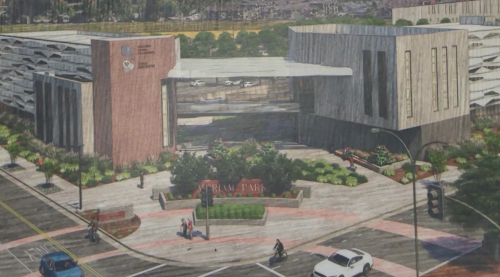Interprofessional Healthcare Campus

Interprofessional Healthcare Campus (IHC)
Purpose and Design
Version: 1.4
Date: 10/24/2024
Vision Statement
The IHC envisions an integrated, multidimensional campus offering state-of-the-art facilities, including an Education campus/Medical school, Simulation centers, Outpatient clinics, Inpatient care, and an Administration school, all interconnected by a robust Medical Informatics core. By cultivating a diverse spectrum of healthcare professionals— MAs, RNs, NPs, PAs, DOs, MDs, and more—we aim to foster a culture of collaborative learning and patient care. With innovations in didactics, simulation, and both virtual and hands-on care, the IHC strives to be a leader in shaping the future of holistic healthcare delivery.
Mission Statement
Empowering a generation of team-based health professionals to deliver socially aware, value-driven care, tailored to the unique needs of individuals and communities.
Necessity and Challenges Addressed
- Addressing the declining access to healthcare in rural Northern California.
- Enhancing interprofessional collaboration and team-based care across disciplines.
- Providing experiential learning in high-intensity medical environments such as ICUs, ERs, ORs, Labor & Delivery, and robotics.
- Fostering leadership, mentorship, and collaborative management skills within the healthcare profession.
- Advancing healthcare toward becoming a High Reliability Organization (HRO) through the integration of data analytics, augmented intelligence, and transparent accountability mechanisms.
- Mitigating the burden of educational debt, which often shifts the focus from patient-centered care to profit-driven practices.
- Accelerating the educational timeline for healthcare providers to address current and future shortages.
- Bridging the gap between healthcare administrators and providers while reducing administrative overhead.
- Promoting cultural competence, diversity, and inclusivity in medical education.
Design Elements
The IHC is built around five core pillars:
- Didactic Learning (anchored by the UCD School of Medicine, Touro University California and CSUChico School of Nursing)
- Simulation
- Clinical Care (Outpatient and Inpatient)
- Administration
- Health Informatics
Didactic Space
Encompassing approximately 20,000 sq. ft., the didactic space includes flexible auditoriums, breakout rooms, and hybrid spaces connected to the simulation center. From foundational lectures by faculty and visiting experts to immersive virtual reality experiences like Microsoft’s “HoloAnatomy,” the didactic area will be dynamic and adaptable to the evolving needs of medical education.
Simulation Space
Modeled after successful global interprofessional programs, the 20,000 square foot simulation centers will replicate real-world healthcare environments, such as:
- ICU: Featuring settings from Neonatal and Pediatric ICUs to Burn ICUs.
- ED: A comprehensive Level 1 Trauma ED, designed for disaster response, triage, high-level isolation rooms, and mental health evaluations.
- OR: Equipped for training in robotic surgery, trauma, cardiovascular, gastrointestinal, neuro, and OB/GYN procedures.
- Crisis Unit: An integrated care system for addressing both community-wide and individual crises, with support from medical informatics to ensure holistic treatment.
Clinical Spaces
- Outpatient Care: A reaffirmation of the importance of outpatient services, offering everything from primary care to specialized interventions. This will be supported by ancillary services, including imaging, pharmacy, and social services, as well as community outreach efforts in collaboration with public entities such as CSU Chico.
- Inpatient Care: In partnership with local nonprofit hospitals, this space will focus on addressing the gaps in inpatient mental health services in the region.
Administration Space
The administrative space will streamline key functions, fostering a culture of collaboration and innovation. The strategic leadership team in keeping with models of best practice will be a triad of leaders in the domains of clinical leadership, administrative leadership, and a lead in patient safety, quality, and system integrity. A dyad leadership model of care providers working side by side with managers will guide best practices in patient care and population health, reinforcing a patient-centric approach.
Additionally, the administrative space will host the center for leadership studies and administrative sciences to bring metrics and key performance indicators to the administration and management of healthcare. There will be a dedicated focus on leadership development; this space will house a leadership academy that blends tradition with innovation, grounded in best practices for patient care and population health.
Medical Informatics Space
- Network Operations Center: Proactive and service-oriented, ensuring seamless coordination between all other spaces and enhancing both learning and care delivery.
- Innovation and Collision Space: A hub for collaboration, promoting the exchange of new ideas and cutting-edge research in medical informatics.
- Human Performance Lab: Dedicated to testing, validating, and designing the next generation of health informatics tools and wearable technologies.

